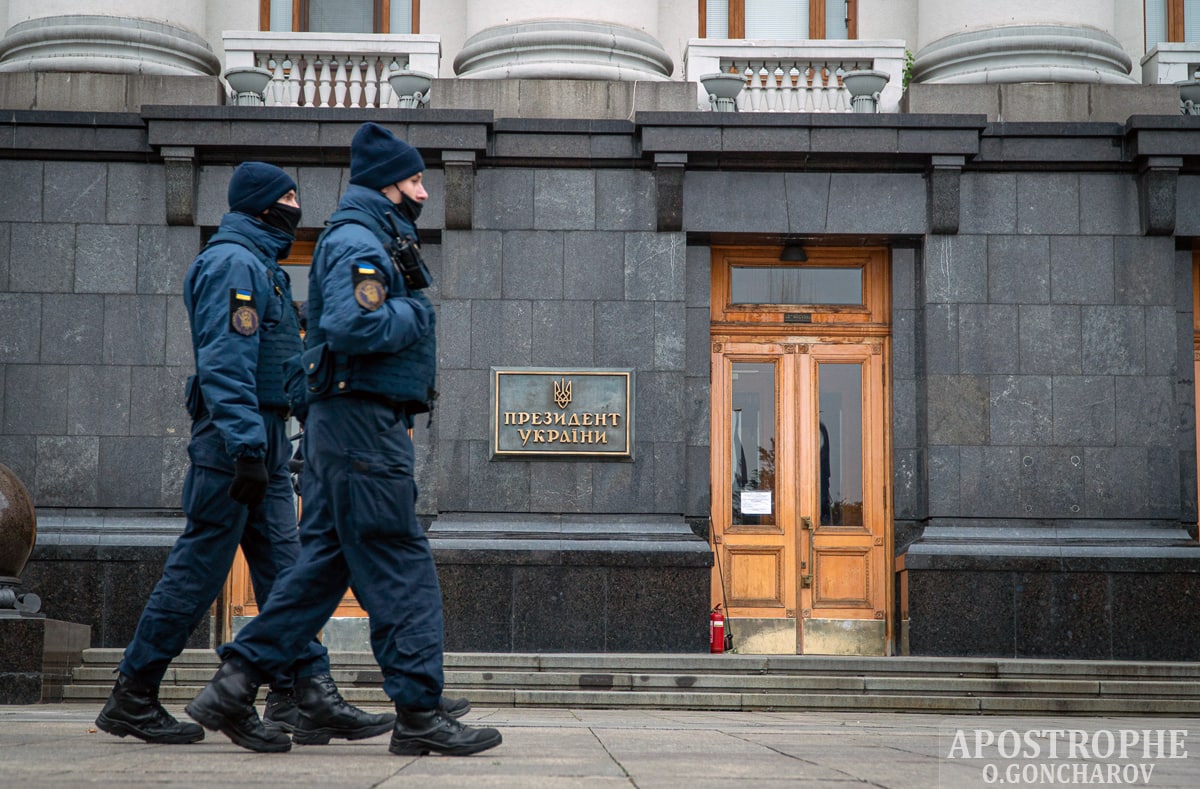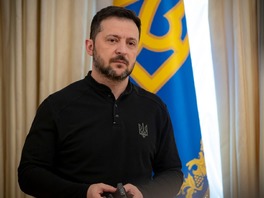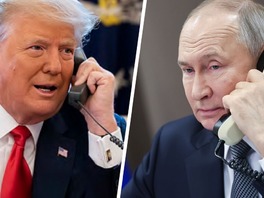The threat of Russian invasion, a fierce Russian-American diplomatic sparring, as well as hysteria in the foreign information campaign concerning Ukraine are becoming chief destabilizing factors for Ukraine's domestic policy in early 2022. Despite widespread skepticism in Ukrainian political circles regarding the possibility of a full-scale Russian invasion, Kyiv cannot ignore the tectonic shifts surrounding the country and is forced to adjust its domestic political agenda to the potential escalation. At the same time, the analysis of possible actions, costs, and benefits for the Russian Federation stemming from large-scale aggression allows one to assess it as low probability. More likely, Russia might intensify the use of hybrid aggression tools, such as cyberattacks on government structures that have taken place in recent weeks. The escalation in Eastern Ukraine is also a possible scenario, with active hostilities being used to attempt the seizure of new territories. This, in turn, would likely incite significant destabilization in the capital. Any attempts to implement the Minsk agreements may also invoke the anger (and chaos) of right-wing radicals. Against this backdrop, Zelensky's "anti-oligarchic" campaign and the criminal case against Petro Poroshenko don’t seem even nearly as threatening to Ukraine’s internal stability.
A rational analysis of interests, costs, and benefits for each of the actors involved in the destabilization scenarios described above allows us to conclude that the current turbulence will not have critical consequences for either the political or economic situation in Ukraine. However, the current (mis)information campaign, high psychological stress, and irrational or reckless actions by the government could lead to palpable negative consequences in the next 2-3 months. Ukraine and its international partners should demonstrate the topmost restraint and professionalism to control the situation and avoid any actions that could provoke unpredictable steps on behalf of the Russian Federation.
The Threat of Russian Invasion
The threat of a new Russian invasion – which mere weeks ago appeared illusory to the majority of the Ukrainian political class – is now causing significant stress in Kyiv. Data of the Ukrainian military indicates a low probability of large-scale aggression, and the basic run of a cost-and-benefit analysis illustrates the lack of rationale for a full-scale war. However, the aggressive rhetoric and hysteria stirred up by the media campaign, as well as the active buildup of Russian troops by the Ukrainian border and the narrowing room for diplomacy, all force one to perceive Russian invasion as a real upcoming threat.
Direct Russian aggression along the entire Ukrainian border, an attack on Kyiv or another large city would lead to a full-scale and long-term military conflict. Even having control of the Ukrainian airspace would not make marching into Kyiv a walk in the park for the Russian troops; they would be unable to occupy the capital in a Crimea-like manner. Both the Ukrainian army and civilians could hold the city’s defense for many months. The number of casualties would count tens or even hundreds of thousands, as well as millions of refugees. This scenario brings no benefits for Russia that would outweigh the consequences, including both international pressure and potential destabilization in the Russian Federation itself.
Therefore, both the government and the expert community consider an akin scenario highly unlikely. More likely scenarios include hybrid aggression, such as cyberattacks or attacks on critical infrastructure, or local conflicts. It is easy enough to imagine the resumption of hostilities in the Donbas; a provocation that would provide pro-Russian militants and Russian troops under the guise of so-called LDPR military corps with an impetus to expand their territory. In this case, the takeover of a new big city or significant military losses could shake Ukrainian society and carry a destabilizing effect. If the Ukrainian government exhibits weakness and indecision, the accusations of failing to defend the country shall follow. Nationalist forces could attempt organizing large-scale protests demanding a government change and decisive response to the aggressor. While these protests would prove a destabilizing factor, the situation would remain under the control of central authorities if they take adequate steps to organize defense and keep the escalation local, limited to fighting over certain positions.
If we assume Russia made radical decisions on Ukraine, the key task of a new wave of aggression would be to launch irrevocable internal destabilization processes in the country, aiming to either change the government or cause the collapse of Ukraine as a state. A full-scale war would prove to be a tragedy for Russia itself, tying Moscow’s hands for decades and finally turning it into an international pariah. Therefore, we should realistically consider only the scenarios that include Russia finding a pretext to market itself as a peacemaker to Russian society and the whole world. It’s worth noting that even during the Russo-Georgian war in 2008, Russia waited until the bombing of Tskhinvali and did not risk entering Tbilisi. Now there aren’t any arguments either that could justify the intention to start a war without a halfway decent and believable excuse.
Russian aggression, however, may constitute an attempt to launch internal destabilization rather than a full-scale occupation. Therefore, the attempts to implement the Minsk agreements are far more appealing than months of a bloody and protracted conflict with the involvement of regular troops.
As a result of years of propaganda and the dominance of nationalist narratives in the Ukrainian public discourse, any attempts to implement the Minsk Agreements, grant special status to the temporarily occupied territories, or agree on the softer terms of the Steinmeier formula would cause significant backlash from both far-right organizations, political players, and a part of Ukrainian society that would see Zelensky’s actions as a surrender and betrayal. An akin development could trigger a major crisis, especially given the fierce political competition that exists in Ukraine today. This, in turn, would prove a great present for Zelensky’s opponents, as Zelensky would find himself caught in the middle of a situation that he cannot emerge victorious from. Such a scenario would lead to significant internal destabilization, and early elections would look like the easiest way to restore stability.
The Petro Poroshenko Case
The prosecution of Petro Poroshenko has receded into the background today but remains a potentially destabilizing factor. The court’s decision to merely restrain Poroshenko in the form of a personal obligation relieved public tensions, but also confirmed the ex-president to be a suspect. Many perceived such a light preventive measure as a sign of weakness from the authorities. The process goes on, and will soon be heading into the appeal.
Both sides will strive to use the case in their political interests. For the Presidential Office, it is important to prove the cooperation between Poroshenko and Medvedchuk to deprive Poroshenko of some electoral support. Poroshenko, on the other hand, aims to portray himself as a victim of Zelensky’s ungrounded persecution. While Poroshenko’s high anti-ratings prevent him from growing his electoral base, potential miscalculations or the demonstration of weakness by the government can help Poroshenko regain political influence or increase support.
Overall, the Poroshenko case is unlikely to cause public backlash or political turbulence. The ex-president is currently unable to unite either society or the political community. However, this case can become an indirect trigger, testifying to the selectivity of justice and causing social unrest under certain favorable conditions. In that case, the opposition, including Poroshenko, could use this situation to organize mass protests and change the government.
The Exacerbation of Parliamentary Struggle and De-Oligarchization
In the new political season, there is a possibility that Parliament might become both a place of political struggle between the government and the opposition and a platform for Zelensky’s confrontation with the oligarchs, mainly Akhmetov. At the moment, however, it appears that Zelensky and Akhmetov have taken a reprieve from their dispute. As a result, Akhmetov’s media have been less critical of the government, and Bankova has refrained from any new steps to attack the oligarch. There's been information that Zelensky and Akhmetov reached certain agreements, in particular concerning the government repaying its debts to Akhmetov’s green energy enterprises. However, the situation may change, as Zelensky is not giving up on his idea of the oligarch register – a register Akhmetov doesn’t want to be included in.
Therefore, it is likely that an attempt will be made to destroy Zelensky’s single-party majority, depriving him of influence in the Parliament. The weak link(s) in the Servant of the People party is single-constituency MPs, who have the weakest connection with the faction and whose withdrawal from it will not lead to them losing their mandates. If one of the oligarchs manages to persuade 16 MPs from the Servant of the People party to leave the faction, Zelensky’s majority will virtually cease to exist. However, in this case, it is also necessary to prevent non-partisan MPs or representatives of parliamentary groups from joining the faction.
However, even if it proves impossible to formally dissolute the majority, a withdrawal of a significant number of MPs from the Servant of the People faction will be a strong blow to the positions of both Zelensky and his party. It will also be an argument to call for early elections, inevitably leading to serious political turbulence and fierce political competition, with Zelensky no longer having the prospect of forming a majority. This scenario would warrant a coalition, narrowing the window of opportunity for the incumbent president. If a difficult socio-economic or energy situation adds to the factors mentioned above, there could be widespread social protests and increasing demand for early presidential elections.
As of now, this scenario appears unlikely. However, the key here will be the socio-economic situation in the country, as well as the state of Ukraine's energy system at the completion of the heating season. If neither of these areas is in critical condition, the opposition and other stakeholders will have few arguments to call for early elections, making it difficult to provoke Ukrainians to protest.
Zelensky, in turn, could respond to attempts to dismantle his single-party majority with increased authoritarian tendencies, including the excessive use of the National Security and Defense Council and the imposition of sanctions. However, in this situation, there must be a clear act of arbitrariness, which will be perceived negatively either by the majority of Ukrainians or the most active part of Ukrainian society.
It’s also worth noting the potential decline in the legitimacy of the government. Given the rapid decline in the ratings of both Zelensky and his party, one should expect a significant intensification of political competition. So far, it seems that Zelensky has formed an electoral core of at least 20%, which is a safe figure for the incumbent president. However, if the situation worsens and the ratings deteriorate, the president will become a lame duck, and all influential players will start changing bets, looking for an alternative.
Conclusions
Currently, the incentive for organized protest is rather low in Ukraine. The threat of Russian aggression plays in the government’s favor, even though it is barely used as a tool for compliance. The West’s sudden attention to the threat of renewed Russian aggression and its corresponding statements have had an effect on Ukrainian society.
Nobody can deny that the current most significant threat to Ukraine’s internal stability is a potential invasion by Russia. Depending on the actions of the authorities, the situation can either unite or divide Ukrainian society if Zelensky fails to respond appropriately. At the same time, one should not expect a large-scale invasion, but a local escalation may trigger irreversible internal political processes in the country.
The implementation of the Minsk agreements on Russia’s terms may also provoke a crisis. If Zelensky is pressured into it, one should expect widespread protests that are likely to turn violent, leading to critical political consequences in Ukraine. It is not about the change of government alone; it is about a brutal schism within Ukrainian society.
At the same time, the political struggle – both between the opposition and the government, and the government vs. oligarchs – remains acute, which could lead to considerable turbulence. The Parliament will serve as the primary platform for these disputes, where one should expect attempts to dissolve Zelensky’s majority and weaken Bankova’s influence on the Verkhovna Rada. The Mevedchuk-Poroshenko case will add momentum to the government-opposition relations. However, there will be a real threat to Ukraine’s internal political situation only if there is a sharp deterioration in the socio-economic situation of Ukrainian citizens and the lack of appropriate action by the authorities. That is, political and socio-economic factors together can lead to destabilization in the country, but each of these factors on its own would not cause serious destabilization.
A critical decline in Zelensky's legitimacy seems unlikely thus far, as the president has already formed an electoral core (20%). However, a rapid deterioration of Zelensky’s ratings will increase political turbulence, and Zelensky himself may turn into a lame duck.





